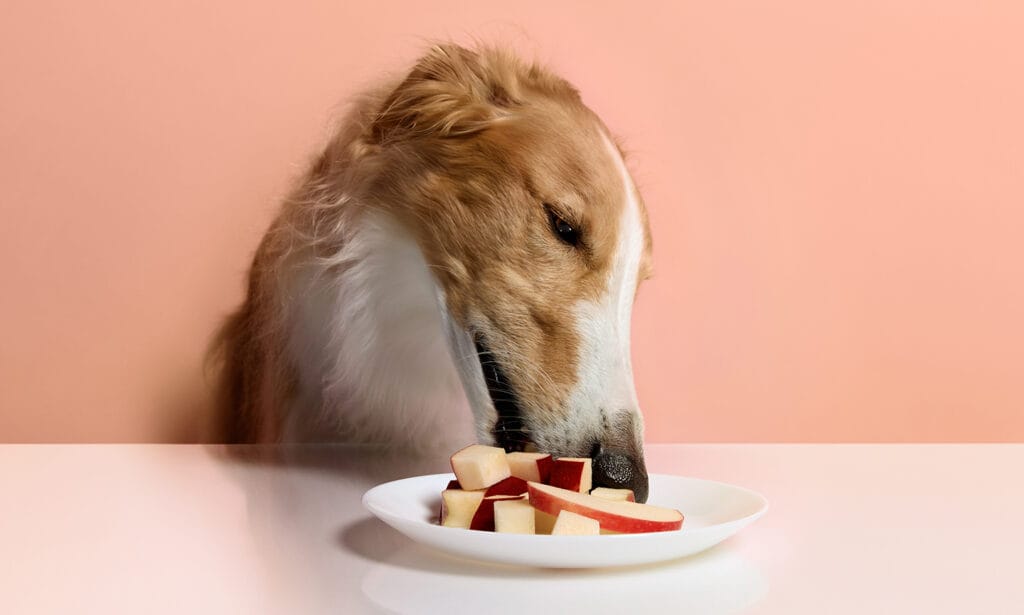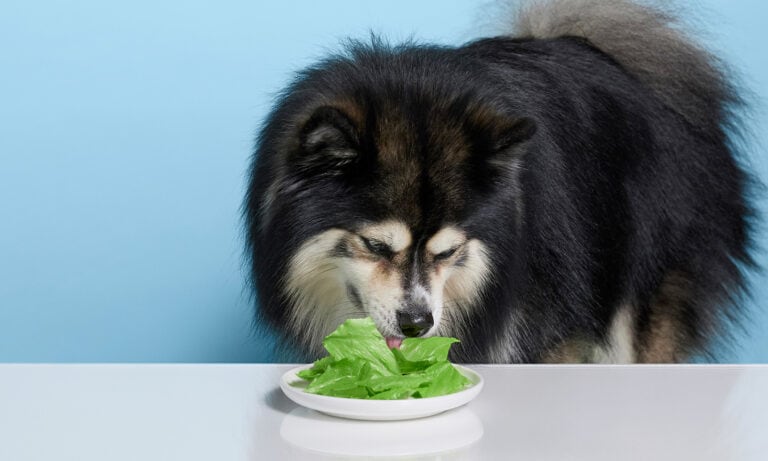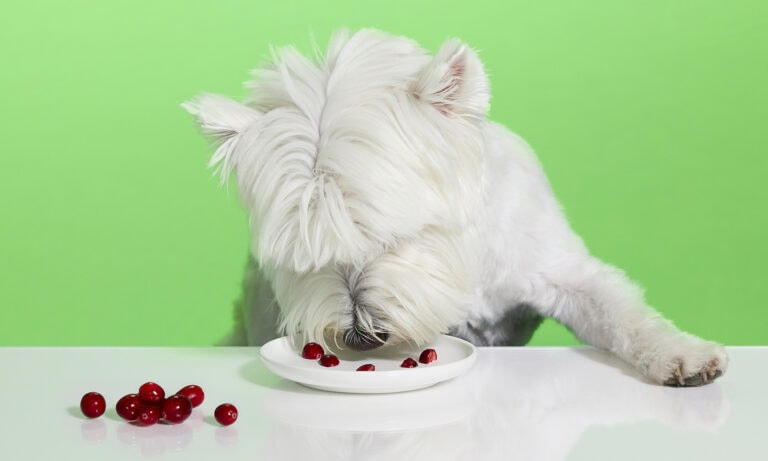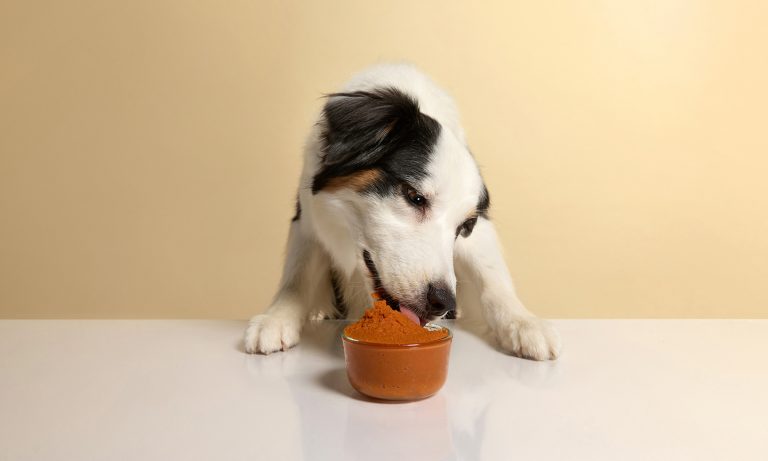You’re snacking on a bowl full of juicy, chopped watermelon, but can your dog have a taste too? What fruits can dogs eat? Several fruits, from apples to watermelon, make great snacks for dogs—as long as they’re served in moderation.
And not only are they OK for your canine companion to enjoy as treats, but they may also offer health benefits. Conversely, a handful of fruits are no-gos.
Before introducing any new food into your dog's diet, always check with your veterinarian.
Fruit That Dogs Can Eat
Click on a fruit to learn more.
Apples

- Health benefits: Excellent source of vitamin C; contain potassium and antioxidants; fiber-rich
- How to prepare: Remove the core, stem, and seeds because they can be toxic, are hard to digest, and may cause your dog to choke. Then, cut into bite-size pieces.
- How much to serve: 1–2 slices, depending on your dog’s weight
- Our favorite apple-flavored dog treat: Blue Buffalo Health Bars Baked with Apples & Yogurt Dog Treats
- Learn more about apples for dogs.

- Health benefits: High in potassium; low in sodium; good source of vitamin B6, vitamin C, magnesium, and manganese
- How to prepare: Remove the peel and cut into bite-size pieces or mash for smaller dogs.
- How much to serve: 1–2 slices for smaller dogs; up to half of a medium-size banana for larger dogs
- Our favorite banana-flavored dog treat: Wholesome Pride Banana Bites Dehydrated Dog Treats
- Learn more about bananas for dogs.
Blackberries
- Health benefits: Great source of antioxidants and polyphenols; rich in fiber, manganese, folate, and omega-3 fatty acids; contains vitamins A, B, C, E, and K.
- How to prepare: Wash thoroughly and cut into pieces or mash for smaller dogs.
- How much to serve: 1–3 berries for smaller dogs; 3–5 berries for larger dogs
- Our favorite blackberry-flavored dog treat: Bark Bistro Superberry Snoot Buddy Budder Lickable Dog Treat
- Learn more about blackberries for dogs.

- Health benefits: Antioxidant-rich; high in fiber; low-calorie
- How to prepare: Wash thoroughly. Serve whole to larger dogs or mash for smaller dogs.
- How much to serve: 1–3 berries for smaller dogs; 3–5 berries for larger dogs
- Our favorite blueberry-flavored dog treat: Pupford's Train Freeze-Dried Blueberry Dog Training Treats
- Learn more about blueberries for dogs.
Cantaloupes
- Health benefits: Contains vitamins A, B, and C; high in fiber, beta-carotene, potassium, magnesium, thiamine, niacin, pantothenic acid, antioxidants, and folic acid; hydrating
- How to prepare: Wash, remove outer rind, scoop out seeds, and slice into 1-inch wedges; then, chop wedges into bite-size pieces.
- How much to serve: 1–2 cubes for smaller dogs; 4–5 cubes for larger dogs
- Learn more about cantaloupes for dogs.
Cranberries
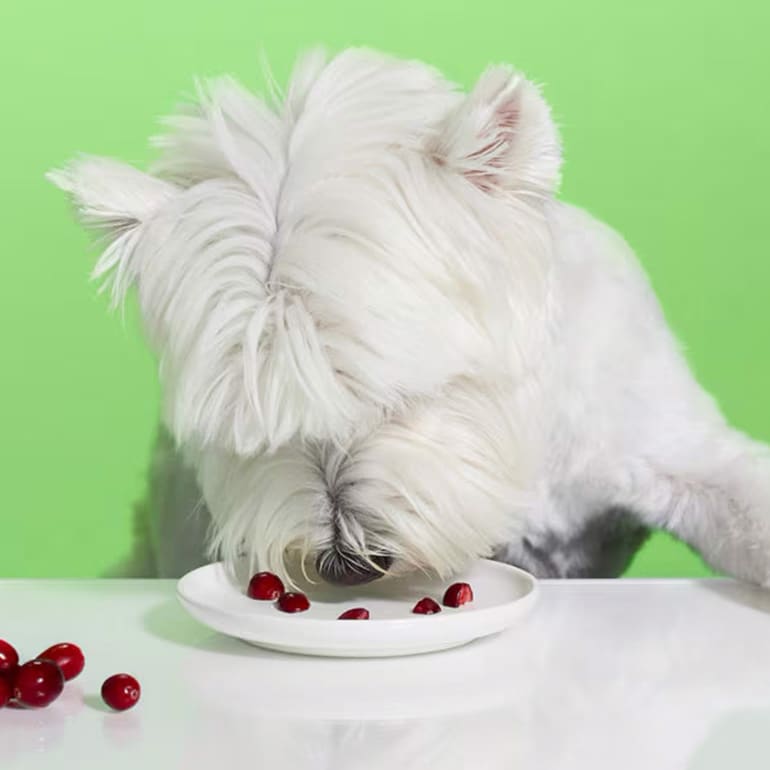
- Health benefits: Good source of manganese, copper, and vitamins C, E, K, B1, and B2; fiber- and antioxidant-rich; may help manage urinary tract infections (UTIs)
- How to prepare: Wash cranberries and place them in a saucepan with water. Cover and simmer until tender (about 30 minutes). Strain and cool before serving.
- How much to serve: 2 teaspoons for small dogs; up to 2 tablespoons for large dogs
- Our favorite cranberry-flavored dog treat: Hill's Natural Fruity Snacks with Cranberries & Oatmeal
- Learn more about cranberries for dogs.
Cucumbers
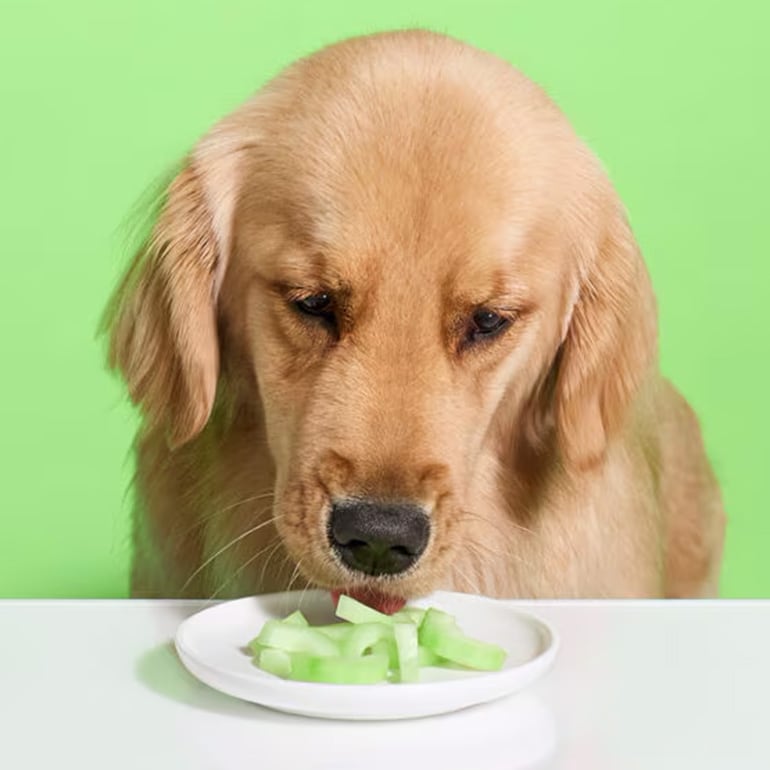
- Health benefits: Excellent source of vitamins B, C, and K; rich source of potassium and magnesium; low-calorie; hydrating
- How to prepare: Wash, peel (not required), and remove the seeds; then, cut into bite-size pieces.
- How much to serve: 1–2 bite-size pieces for small dogs; 3–4 bite-size pieces for large dogs
- Our favorite dog treat with cucumber: Shepherd Boy Farms Freeze-Dried Raw Goat’s Milk Super Greens Blend
- Learn more about cucumbers for dogs.
Kiwis
- Health benefits: Excellent source of vitamins C, E, and K; rich in potassium and calcium; fiber-rich
- How to prepare: Remove the skin, then cut into small pieces.
- How much to serve: 1/2–1 slice for small dogs; 1–2 slices for large dogs
- Our favorite dog treat with kiwi: Choolip Squeeze Vita Stick Lickable Dog Treats
- Learn more about kiwis for dogs.
Mangoes

- Health benefits: Contains vitamins A, B6, C, and E; high in fiber
- How to prepare: Remove the skin and pit, then cut into 1/2-inch cubes.
- How much to serve: 1–2 cubes for small dogs; 3–4 cubes for large dogs
- Our favorite mango-flavored dog treat: Fruitables Skinny Minis Pumpkin & Mango Soft Dog Treats
- Learn more about mangoes for dogs.

- Health benefits: Contains vitamins A, C, B1, and B6; good source of fiber, potassium, calcium, folic acid, flavonoids, and phytonutrients
- How to prepare: Remove the rind and seeds, then slice into wedges.
- How much to serve: Half a wedge for small dogs; 1 wedge for large dogs
- Learn more about oranges for dogs.
Pears
- Health benefits: Contains vitamins A, C, K, E, B1, and B2; source of folic acid, niacin, phosphorus, potassium, copper, and pectin; fiber-rich
- How to prepare: Wash, then remove skin, stem, core, and seeds. Cut into bite-size pieces.
- How much to serve: Half a wedge for small dogs; 1 wedge for large dogs
- Our favorite pear-flavored dog treat: Fruitables Alaskan Salmon & Pear Whole Jerky Bites
- Learn more about pears for dogs.
Pineapples
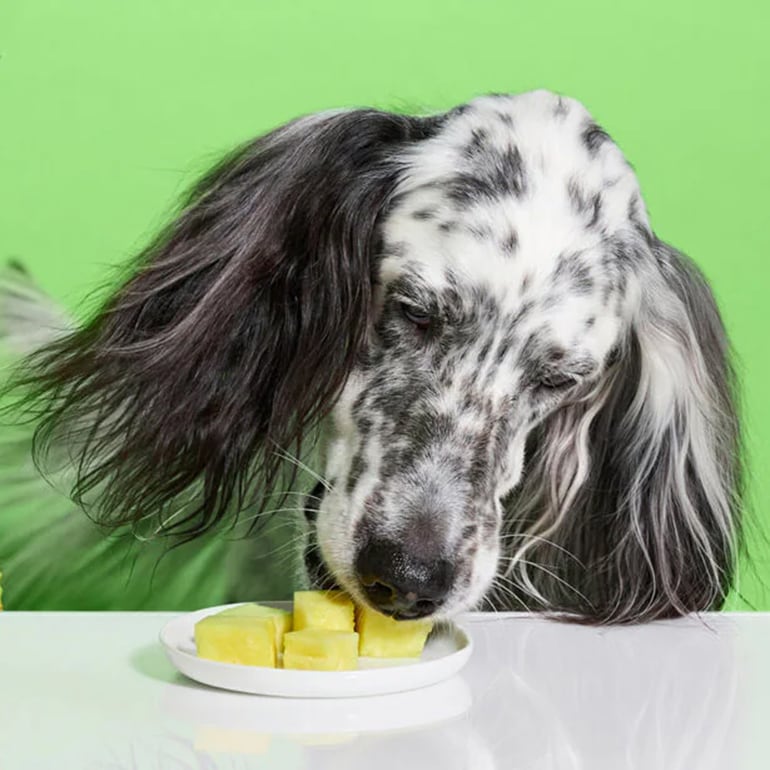
- Health benefits: Hydrating and fiber-rich
- How to prepare: Peel and core, then cut into bite-size pieces.
- How much to serve: 1–2 pieces for small dogs; 2–3 pieces for large dogs
- Our favorite pineapple-flavored dog treat: Pawfect Yogurt with Pineapple Dog Treat
- Learn more about pineapples for dogs.

- Health benefits: Great source of vitamins A and C; rich in potassium; promotes a healthy gut
- How to prepare: Peel, remove seeds, then roast. Allow to cool, then mash or puree without sugar or salt.
- How much to serve: 1–3 teaspoons for small dogs; 1–4 tablespoons for large dogs
- Our favorite pumpkin-flavored dog treat: Weruva Pumpkin Patch Up! pouches
- Learn more about pumpkins for dogs.
Raspberries
- Health benefits: Excellent source of vitamins C, B complex, and K; rich in potassium, manganese, copper, iron, and magnesium; fiber- and antioxidant-rich; low-calorie
- How to prepare: Wash thoroughly, then mash before serving to smaller dogs.
- How much to serve: 1–2 berries for small dogs; 3–4 berries for large dogs
- Learn more about raspberries for dogs.
Strawberries

- Health benefits: Rich in vitamins C and B9; high in potassium, magnesium, and folic acid; loaded with fiber; low-calorie
- How to prepare: Wash, remove stems, and chop into smaller pieces.
- How much to serve: 2–3 slices for small dogs; 5–7 berries for large dogs
- Our favorite strawberry-flavored dog treat: Fruitables Yogos Strawberry & Banana Flavor Grain-Free Dog Treats
- Learn more about strawberries for dogs.

- Health benefits: Great source of vitamins A, C, B1, B5, and B6; rich in potassium and magnesium; antioxidant-rich and low-calorie; hydrating
- How to prepare: Remove the skin, rind, and seeds, then chop into smaller pieces.
- How much to serve: 1–2 bite-size chunks for small dogs; 3–4 chunks for large dogs
- Our favorite watermelon-flavored dog treat: Lord Jameson Watermelon Pops Soft Dog Treats
- Learn more about watermelons for dogs.
What Fruit Can Dogs Not Eat?
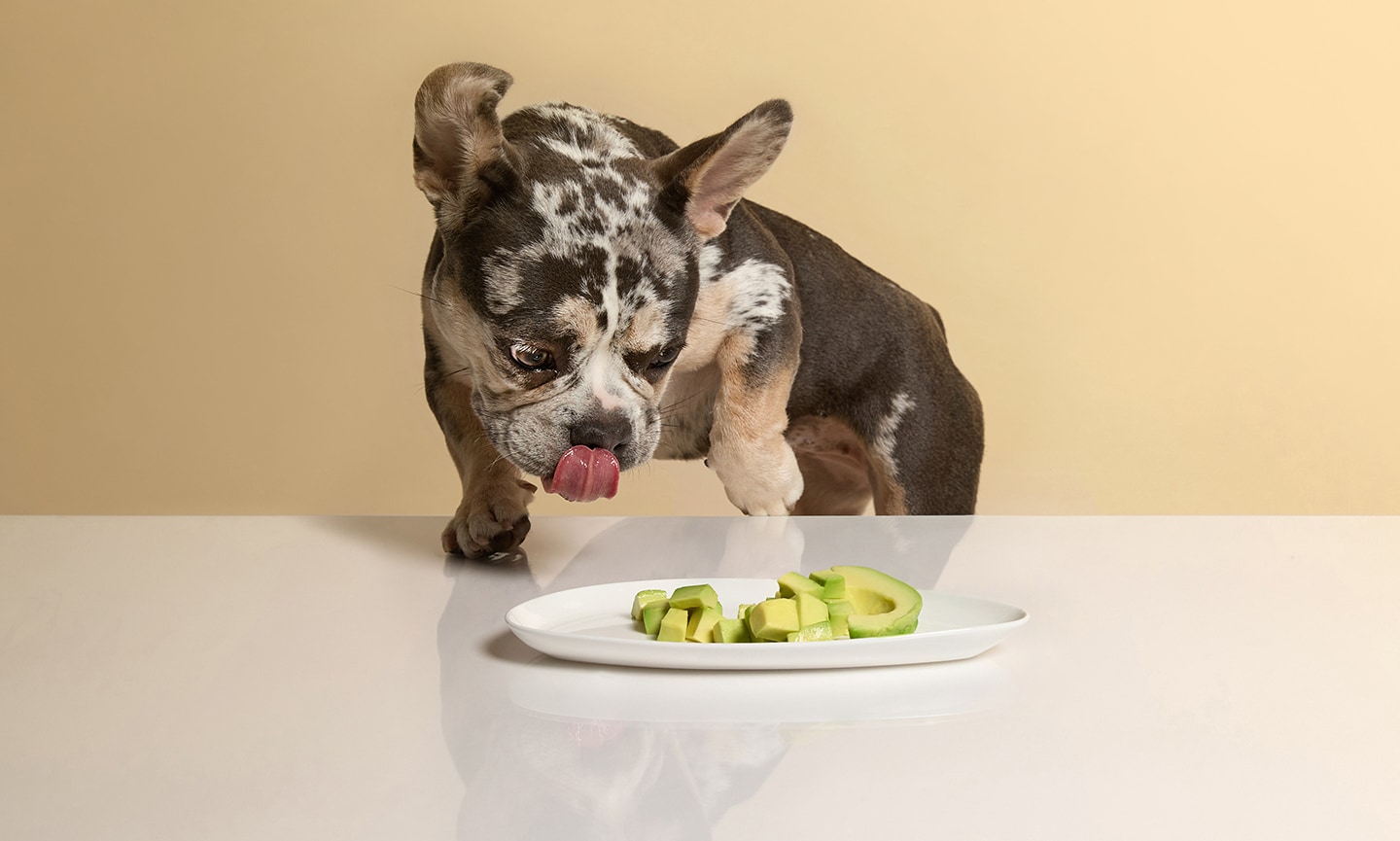
Dogs and fruit don’t always go together. If your dog eats any of the following fruits, call your veterinarian or the Pet Poison Helpline (855-764-7661, a consultation fee applies) for next steps.
Avocados
Avocados can be dangerous for dogs for two main reasons:
- Avocados are high in fat and can lead to pancreatitis.
- Avocados contain persin, a toxin that can cause vomiting, diarrhea, and other health problems, especially in large amounts.
Cherries
Cherries are a no-go for dogs because:
- Cherry pits contain cyanide, which can be toxic to dogs.
- Cherry pits can pose a choking hazard and have the potential to cause an intestinal blockage.
Grapes and Raisins
Even a small amount of grapes or raisins can cause kidney failure, making them one of the most dangerous fruits to avoid.
Limes
Limes are high in citric acid, which can cause stomach upset in higher quantities.
Additionally, lime rinds contain essential oils and psoralens (phototoxic compounds) that can cause GI upset, central nervous depression, and loss of coordination.
Plums, Apricots, and Peaches
Plums and related fruits are dangerous for dogs for a couple reasons:
- Like cherry pits, plum, apricot, and peach pits contain cyanide. The seeds inside the pits, as well as the stems and leaves, have compounds that can produce cyanide.
- The pits can also pose a choking hazard or cause an intestinal blockage.
FAQs About Dogs and Fruit
Q: What fruit is best for dogs?
A: Blueberries, apples, watermelon, bananas, and cranberries are some of the best fruits for dogs.
Q: What fruits are poisonous to dogs?
A: Grapes and raisins are toxic to dogs. The pits of cherries, plums, apricots, and peaches cherry and plum pits contain a toxic compound called cyanide and can pose a choking hazard or block a dog’s intestinal tract.
Q: What vegetables can dogs eat?
A: Dogs can eat many vegetables, including cooked asparagus, carrots, broccoli, cauliflower, and peas.
This content was medically reviewed by a veterinarian.
Share:
